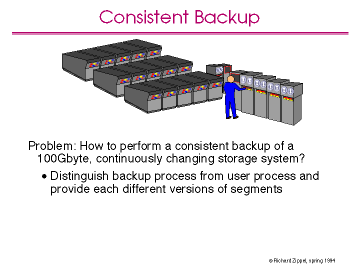
Back to the previous slide, on to the next slide or up to the storage overview
One example of where the microstorage architecture does provide added performance performing a consistent backup of a large disk farm. On many systems this is quite difficult, because the data on these disks is always changing. The only way to provide a consistent backup is to prohibit writes on the disks during the backup. Usually this means shutting own the disks for the several hours require to perform the backup. This is not feasible for most large storage systems.
Using the microstorage architecture, one can easily implement a scheme that was originally patented by IBM for use in the I/O channel based disk systems. At the microstore level we distinguish two different types of processes -- backup processes and all others. At the beginning of a backup each machine is asked to mark all segments in memory as read-only. From then on, if a user process modifies the segment, the original value of the segment is preserved and a new read/write copy is provided for the user process. Similar actions are provided for all segments that are brought into memory. However, when backup processes request a pointer to a segment they will be given the original segments. This process is requires only a minimal pause in the operation of the system when the backup is initiated. Note that this technique permits consistent backup of all storage servers concurrently. This is typically difficult in other implementations.
Caching can also be improved by having the microstore optimize the use of cache memory across all the storage servers, rather than optimize each independently. This will give better overall system performance for a given amount of cache memory than independently optimized systems.
Richard Zippel